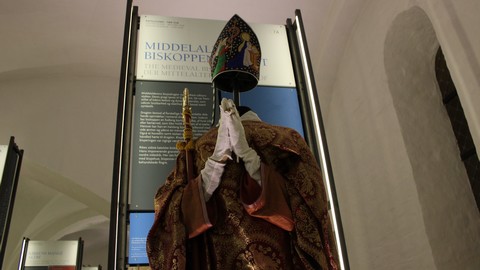The reconstruction of a medieval bishop’s vestments, constructed on the basis of written sources, surviving garments and, in particular, medieval visual sources, in which bishops are depicted in colourful and expensive robes.
For example, in the Cathedral there is a large gravestone that conceals Ribe’s last Catholic Bishop, Iver Munk, who died in 1539.
The gravestone shows the Bishop wearing his fine vestments with his mitre, his crozier and an abundance of rings on his gloved fingers.
The embroidered mitre, which is part of the vestments, is based on a similar embroidered mitre found in a Late Medieval grave in the Cathedral.
Medieval bishops’ vestments consisted of expensive paraphernalia. Their pomp was in honour of God. They were made using the finest and most expensive materials of the time. In addition to their value and beauty, they were also symbolic.
The robe consisted of several layers, the individual elements of which stemmed from traditional Roman clothing.
On the inside the bishop wore a full-length kirtle, an alba, of white silk or linen, which was held together by a belt. Over this he wore a half-length silk kirtle with wide arms, and over this a chasuble or cloak. The costume also included headwear and trimming around the neck and wrists.
The bishop’s mitre, the bishop’s crozier and the bishop’s ring were important symbols of dignity.
